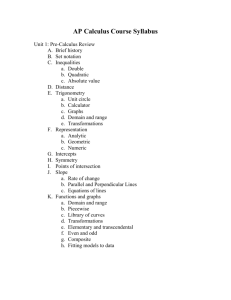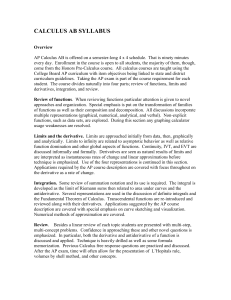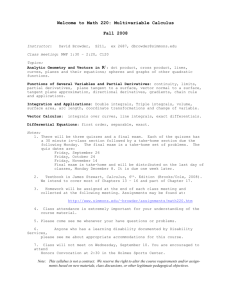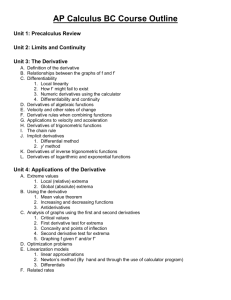AP Calculus Syllabus - Huntsville High School
advertisement
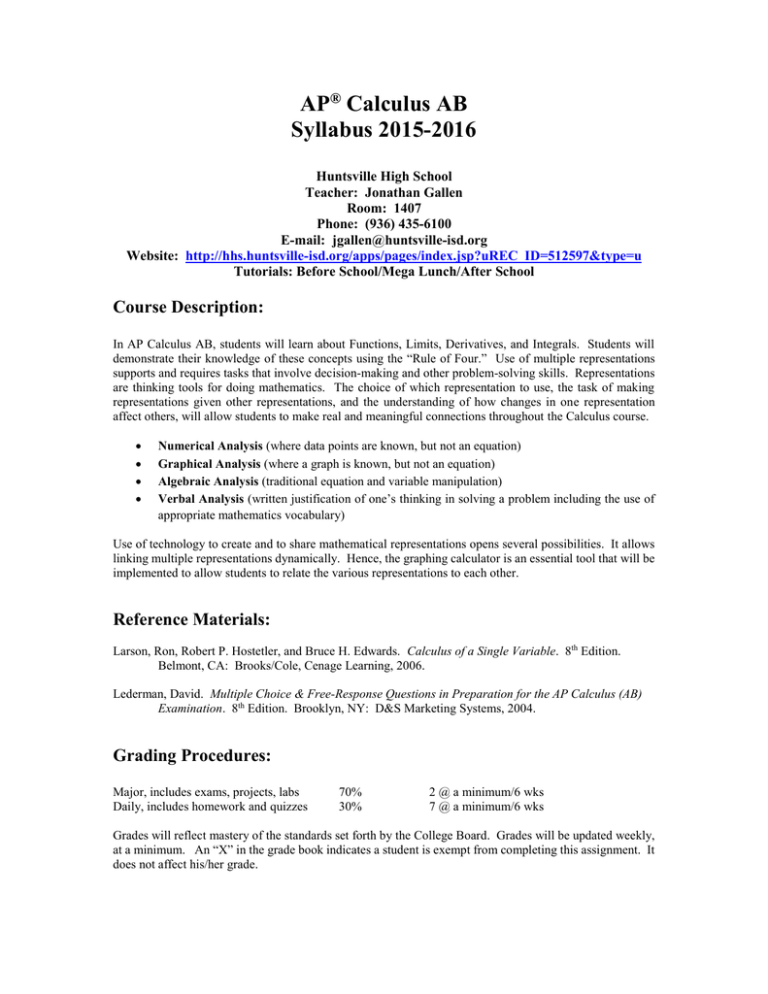
AP® Calculus AB Syllabus 2015-2016 Huntsville High School Teacher: Jonathan Gallen Room: 1407 Phone: (936) 435-6100 E-mail: jgallen@huntsville-isd.org Website: http://hhs.huntsville-isd.org/apps/pages/index.jsp?uREC_ID=512597&type=u Tutorials: Before School/Mega Lunch/After School Course Description: In AP Calculus AB, students will learn about Functions, Limits, Derivatives, and Integrals. Students will demonstrate their knowledge of these concepts using the “Rule of Four.” Use of multiple representations supports and requires tasks that involve decision-making and other problem-solving skills. Representations are thinking tools for doing mathematics. The choice of which representation to use, the task of making representations given other representations, and the understanding of how changes in one representation affect others, will allow students to make real and meaningful connections throughout the Calculus course. Numerical Analysis (where data points are known, but not an equation) Graphical Analysis (where a graph is known, but not an equation) Algebraic Analysis (traditional equation and variable manipulation) Verbal Analysis (written justification of one’s thinking in solving a problem including the use of appropriate mathematics vocabulary) Use of technology to create and to share mathematical representations opens several possibilities. It allows linking multiple representations dynamically. Hence, the graphing calculator is an essential tool that will be implemented to allow students to relate the various representations to each other. Reference Materials: Larson, Ron, Robert P. Hostetler, and Bruce H. Edwards. Calculus of a Single Variable. 8th Edition. Belmont, CA: Brooks/Cole, Cenage Learning, 2006. Lederman, David. Multiple Choice & Free-Response Questions in Preparation for the AP Calculus (AB) Examination. 8th Edition. Brooklyn, NY: D&S Marketing Systems, 2004. Grading Procedures: Major, includes exams, projects, labs Daily, includes homework and quizzes 70% 30% 2 @ a minimum/6 wks 7 @ a minimum/6 wks Grades will reflect mastery of the standards set forth by the College Board. Grades will be updated weekly, at a minimum. An “X” in the grade book indicates a student is exempt from completing this assignment. It does not affect his/her grade. Class Participation: All students will have ample opportunity to receive bonus points on major exams through class participation in warm-ups, lectures, and class reviews. Popsicle sticks will be used to randomly select students (in the concept of fairness) to be given the opportunity to earn bonus points by answering questions in class using appropriate academic vocabulary. An entire class may earn bonus points through class activities as well. Class participation is strongly encouraged. Students may also have the opportunity to earn bonus points by attending tutorials and completing homework problems. Assignments: An assignment will be given regularly. The assignment is for your benefit. It is a chance to practice what you’ve learned and a place to receive feedback. You will have ample opportunity to ask questions about the assignment both during class and tutorials. One or more HW quizzes will be given during each unit. The HW quiz will consist of answers to homework problems the students have been working on during that unit as well as an in-class portion. The out of class portion will count 60% and the in-class portion will count 40%. Each HW quiz will count as 2 daily grades in gradebook. ALL WORK MUST BE SHOWN in order to receive credit. Students will have the opportunity to take a Formula Quiz during all six weeks. The Formula Quiz will be used as a daily grade replacement. The Formula Quiz will include major formulas/concepts required for success in AP Calculus (more will be added throughout the year). The Formula Quiz can be taken as many times as possible during the six weeks (only once per day) and must be taken during tutorials only. Late Work Policy: Academic Practice (Daily Grades): Late work will be accepted up to two (2) days past the due date for half credit. After the two (2) days have passed, NO late work will be accepted and a grade of zero (0) will be given for the assignment. Academic Achievement (Major Grades): Late work will be accepted with a penalty of 10 points per day up to five (5) days. After the five (5) days have passed, NO late work will be accepted and a grade of zero (0) will be given for the assignment. Retest/Makeup Policy: Students receiving a grade less than 75 on a major exam will be required to attend tutorials and complete exam corrections within one (1) week of receiving grade. Students can receive up to half-credit back on exam corrections up to a 100. This process will be optional for ALL students. Students must fill out an Exam Corrections Request Form (new grade will NOT go into gradebook until completed form received). Exam corrections will be done on a provided worksheet where ALL WORK MUST BE SHOWN. Students completing exam corrections are not guaranteed credit back. Students shall be expected to make up assignments and exams after absences within five (5) school days for full credit. BYOT: ALL personal electronic devices (including but not limited to cell phones, tablets, laptops, etc.) will be placed in the electronic device tub at the front of the classroom within the first five minutes of class every day and will be picked up during the last five minutes of class. NO personal devices, with the exception of graphing calculators, will be allowed for use during lectures/quizzes/exams. Course Outline: Unit 1: Limits and Continuity (3 Weeks) A. Rates of change B. Limits at a point 1. Properties of limits 2. Two-sided limits 3. One-sided limits C. Limits involving infinity 1. Asymptotic behavior 2. End behavior 3. Properties of limits 4. Visualizing limits D. Continuity 1. Continuous functions 2. Discontinuous functions a. Removable discontinuity b. Jump discontinuity c. Infinite discontinuity E. Instantaneous rates of change Unit 2: Derivatives (5 Weeks) A. Definition of the derivative B. Differentiability 1. Local linearity 2. Numeric derivatives using the calculator 3. Differentiability and continuity C. Derivatives of algebraic functions D. Derivative rules when combining functions A. Applications to velocity and acceleration B. Derivatives of trigonometric functions C. The chain rule D. Implicit derivatives 1. Differential method 2. y’ method E. Derivatives of inverse trigonometric functions F. Derivatives of logarithmic and exponential functions Unit 4: Applications of Derivatives (4 Weeks) A. Extreme Values 1. Local (relative extrema) 2. Global (absolute) extrema B. Using the derivative 1. Mean value theorem 2. Rolle’s theorem 3. Increasing and decreasing functions C. Analysis of graphs using first and second derivatives 1. Critical values 2. First derivative test for extrema 3. Concavity and points of inflection 4. Second derivative test for extrema D. Optimization problems E. Linearization models F. Related rates Unit 5: Definite Integrals (3 Weeks) A. Approximating areas 1. Riemann sums 2. Trapezoidal rule 3. Definite integrals B. The Fundamental Theorem of Calculus (part 1) C. Definite integrals and antiderivatives 1. The Average Value Theorem D. The Fundamental Theorem of Calculus (part 2) Unit 6: Differential Equations and Mathematical Modeling (3-4 Weeks) A. Antiderivatives B. Integration using u-substitution C. Separable differential equations 1. Growth and decay 2. Slope fields 3. General differential equations Unit 7: Applications of Definite Integrals (3 Weeks) A. B. C. D. Summing rates of change Particle motion Areas in the plane Volumes 1. Volumes of solids with known cross sections 2. Volumes of solids of revolution (Disk Method) Unit 8: Review/AP Test Preparation (5-6 Weeks) A. Multiple-choice practice (items from past AP exams are used as well as items from AP prep/review resources) 1. Test taking strategies are emphasized 2. Individual and group practice are both used B. Free-response practice (released items from past AP exams are used as well as items from AP prep/review resources) 1. Rubrics are reviewed so students see the need for complete answers 2. Students collaborate to formulate team responses 3. Individually written responses are crafted 4. Attention to full explanations is emphasized Student Activities: 1. Students will complete a function poster project. Students will be required to demonstrate their knowledge of the 12 basic functions on a poster. They are required to define terms associated with functions (zeros, asymptotes, domain, range, etc.) and give graphical examples. They are also required to show real world applications of these functions and show solutions to those applications. Posters are then put on display providing an opportunity for students to view and discuss each other’s findings. ***Functions*** 2. A tabular investigation of limits of functions is conducted in groups. Next, an analytic investigation of the same functions is conducted in groups. Students discuss with their tablemates any conclusions they can draw. Finally, a graphical investigation (using graphing calculators) is conducted in groups, and then we discuss, as a class, whether the group conclusions are verified or contradicted. ***Limits*** 3. Students will use office rolling chairs to start to discover how to approximate instantaneous rates of change and how they differ from average rates of change. This serves as a lead in into the limit definition of a derivative. ***Derivatives*** 4. A matching game is played with laminated cards that represent functions in four ways: a graph of the function; a graph of the derivative of the function; a written description of the function; and a written description of the derivative of the function. ***Derivatives*** 5. During the study of related rates, students will be given a Tootsie Roll Pop to suck on and determine the rate of change of their radius. They then calculate the rate of change of the Pops’ volume. Students measure the initial radius of a Pop with dental floss. They then suck on the Pop for 30 seconds, record its radius, suck for another 30 seconds, etc. The students model the rate of change of the radius with some function of time. Students then use this rate of change to estimate the rate of change of the volume of the Pop when its radius is 3/4s of its original radius. ***Related Rates*** 6. Students will each be given a bag of miniature M&Ms and graphs of different functions (curves). The M&Ms will be placed under the “curves” and then used to form rectangles to provide approximations for areas under the curves. Students will then use definite integrals to approximate the area under the curves and compare with their rectangular approximations. ***Integrals*** 7. Using a projected calculator screen with the grid turned on, students will be assigned several coordinate points in the region. For a given differential equation, each student computes the slope at his or her coordinate position and then goes to the board to draw a short line segment with the calculated slope and the coordinate point as the midpoint of the segment. Continuing in this fashion, the class would complete the slope field. At this point, all sorts of discussions can ensue. ***Slope Fields*** 8. A matching game is played with laminated cards that represent slope fields in three ways: a graph of the slope field; a differential equation; and a written description of the differential equation. ***Slope Fields*** 9. Cans of Play-Doh are brought to school and students are asked to construct solids whose bases are bounded by two curves and whose cross sections are square or equilateral triangles, etc. Students build the solids using Play-Doh and then use plastic knives or dental floss to cut through the solid and obtain the required cross sections. Students then draw these 3-dimensional objects in their journals and write out the integrals that would give their volumes. ***Solids of Revolution*** 10. As a class, students will add to the “Calculus wall” (a word wall of sorts which embodies a covered up whiteboard with butcher paper) important information, terms, definitions, etc. that the students feel are important to retain for the AP Exam to ensure success. Students will take spiraled quizzes throughout the course over this material to ensure they are retaining the necessary information required to be successful in the course (i.e. algebraic formulas, trigonometry identities/theorems, derivative rules, etc.). ***AP Exam Review*** 11. Each student is given a free response questions to present to the class. As part of the presentation, the class is allowed 12-15 minutes to attempt each question and then the student makes his/her presentation. Students also practice scoring themselves at this time. ***AP Exam Review*** 12. After the AP Exam, students will group up to make music videos about Calculus. Students will take an existing song/music video and rewrite the lyrics to include Calculus concepts they learned throughout the course. The Calculus music videos will not only serve as a major project but also as promotional videos of sorts for the course and as review for future AP Calculus students. ***Future AP Exam Review***
